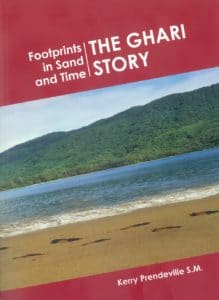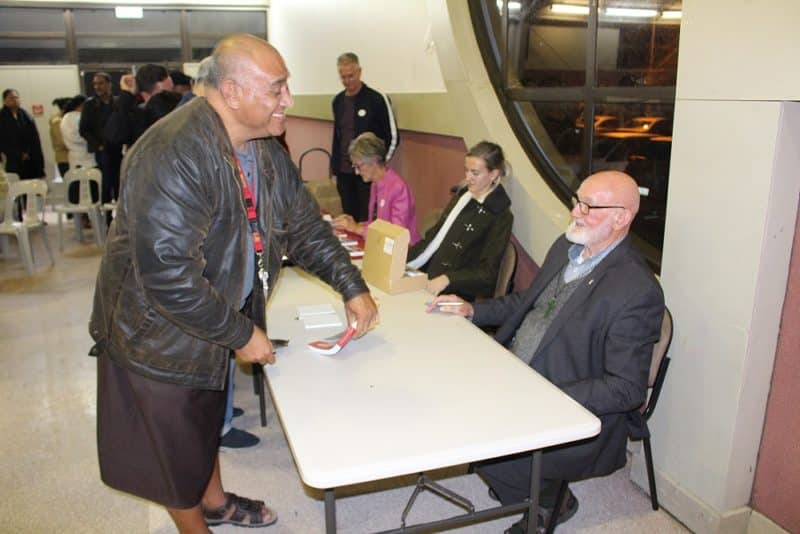The oral stories of a people in the Solomon Islands, stories which were in danger of being lost forever, have been put down in writing by a New Zealand Marist priest.
 “Footprints in sand and time – The Ghari Story”, by Fr Kerry Prendeville, SM, was launched at a function at St Anne’s parish, Manurewa on April 29.
“Footprints in sand and time – The Ghari Story”, by Fr Kerry Prendeville, SM, was launched at a function at St Anne’s parish, Manurewa on April 29.
In the 1970s, Fr Prendeville undertook postgraduate research in anthropology and spent some time working and living with the Ghari people on the Weather Coast of Gaudalacanal.
“After studying anthropology in Papua New Guinea . . . I started to listen to their stories,” Fr Prendeville told the book launch.
He would make tape recordings and write down what he was told.
“They said to me in their own language, Father, why are you taking our story away?”
“It is their story, that they wanted me to tell. That’s how it began. . . .It has taken, I am ashamed, 37 years to fulfill the promise I had made to write down their story and bring it back to them.”
Being released from full-time pastoral ministry in 2019 allowed him to kindle his enthusiasm for the project and gave him the time to write. What was finally produced “relates only some of the more important oral traditions and narratives”, Fr Prendeville wrote in the introduction to the book.
The book has eight chapters – each a “footprint” – starting with prehistory, human settlement of Solomons and early European contact and moving onto Ghari mythology, customs, spirituality, festivals and much more. The great World War II Battle for Guadalcanal gets its own chapter, as does the arrival and impact of Marist missionaries. An epilogue covers more recent history.
One chapter examines the religious festival “Na Sai Na Vitu” – the festival of the seventh month, which was closed down by Anglican and Catholic missionaries in the early 20th century.
People were threatened with excommunication if they talked about Masobaga (one of the most powerful guardian ancestral spirits, who was connected with this festival). So the people would not talk of such things.
According to the book’s introduction, Fr Prendeville found himself “. . . knocking on doors which have been closed by earlier missionaries”.
“These were the doors which elders were reluctant to open to strangers. Yet these were the doors to a vault the author was trying to prise open to get a glimpse inside of the sacred, the world of ancestor spirits and the world-view of yesteryear shrouded in mythology.”
Fr Prendeville, who spent 32 years working in Oceania, wrote that it was critical that the stories of the Ghari people be told.
“[Elders and leaders who went before] . . . their graves are silent, and the dead no longer have a voice, but they do have ears. They are listening to what we do with their wisdom, knowledge and the stories they have told,” he wrote in the introduction.
He added: “The geo-political talk now is about how Melanesia can become more pro-active to survive in a global economy, with the emphasis on conformity to existing European and Asian models. The local communities, with their emphasis on socio-cultural and linguistic diversity, can so easily be lost as nobodies without a cultural heritage nor stories to tell on the Melanesia stage of today and tomorrow.”
In a foreword for the book, Fr Gerard Arbuckle, SM, wrote that . . . “[T]he Ghari culture, in fact no culture, can survive without stories and storytellers. Kerry, by listening to and writing down stories of the Ghari people, has offered them a precious gift, the chance to take charge of their roots and survive as a distinct group of people. This book acknowledges the original hospitality of those people who welcomed him many years ago”.
In March, 2020, Fr Prendeville revisited the Solomons and the Ghari people. As he wrote in the book’s introduction, he spent a week in Sugu and Wanderer Bay, “explaining what had been written and going through details of who said what way back in 1976, the elders and leaders gave unanimous approval for the author to go ahead and publish the book. There was a great deal of interest and enthusiasm . . . .”
At the book launch, Lucina Lata, who lives in Palmerson North, and whose father and grandfather had been two of the principal sources who shared stories with Fr Prendeville, said that the priest is always welcomed in her village, where he is much-loved.
She thanked him for writing the book, which will be an important resource for the young and old of her people.
“Our history is traditionally oral. Story-telling is a way of passing on history . . . between generations. We now have information that can be forgotten as elders grow old,” she said.
Theologian Fr Mervyn Duffy, SM, told the launch that, in order for oral history to be written down, “you have got to have somebody who is trusted to hear the stories and the skills to write them down. And he has got to have the consent of the people. They don’t give that trust to just anybody”.
Fr Duffy added that Fr Prendeville had written his “magnum opus”. “This is the ‘big work’, coming out of a lifetime, and it has come out of a lifetime of getting to know a people, to hear their story, and to present their story back to them in a format that will endure.”
Society of Mary New Zealand provincial Fr Tim Duckworth, SM, told the book launch that the Marists are very proud of Fr Prendeville – “a man who became one of the Ghari people”.
Bringing the speeches at the book launch to a conclusion, Fr Prendeville thanked many people and organisations. He thanked the Society of Mary for supporting the publication of the book, adding that most of the copies would be shipped to Archbishop Christopher Cordone, OP, in the Solomon Islands, who has “set up a group that will take the books around to the Ghari people. They will be distributed on payment into a trust fund set up for tertiary education”.
“But there is no price on the book. So I can put on the shipping form – no commercial value – because they wouldn’t have the money to pay for the real commercial value.”
“It is a gift. It is something I had in the back of my mind for so many years.”
Proceeds from the sales of the book at the launch were to go towards shipping costs.
The book’s epilogue finishes with the following lines in italics.
A story is not a story until it is told and told again by one who was once just a listener. A story empowers a listener who then can empower a community.

Dear Fr. Kerry Prendeville,
Thank you very much for writing our Gari people’s story. I really acknowledge your hard work in putting all these together. Our past generations have gone from this world but that story is a history for our generation to know about trend of pasts and present .
I can’t wait to have a copy of this Book.
Regards,
Selina Berah
Thank you Fr Kerry for the book. A great Privillage for the Ghari People in having their stories being published.Acknowledge your Hard Work.
Dear Father Kerry
I would like to obtain a copy of your Footprints book, but the only selling agent listed online seems on;y to deal with institutions, not individuals. I notice that you have used some of my work from the SI Historical Encyclopaedia. I am in Australia.
Regards
Clive
Dr Clive Moore,
Greetings and apologies for not getting in touch with you earlier.
I would be very happy to send you a copy of “Footprints in Sand and Time – The Ghari Story”
Please contact me at my new address in Christchurch : Marist Community, 11/4 St Basils Court, Sydenham, Christchurch 8023, New Zealand. Ph 027 41987 35. e-mail: [email protected]
Best wishes and I look forward to hear from you.
Kerry Prendeville sm
Thank you, Father for keeping the details of this story intact for this generation. I now have a cultural bedtime story to tell it as it was……. a very symbolic traditional ceremony that captures the particular areas and their people …a piece of our cultural history. Regards.